





































MIDWEEK UPDATE 11 MARCH 2021



COVID 19 REGULATIONS, INITIATIVES AND AEROCLUB NEWS
THE AERO CLUB CENTENARY YEARBOOK
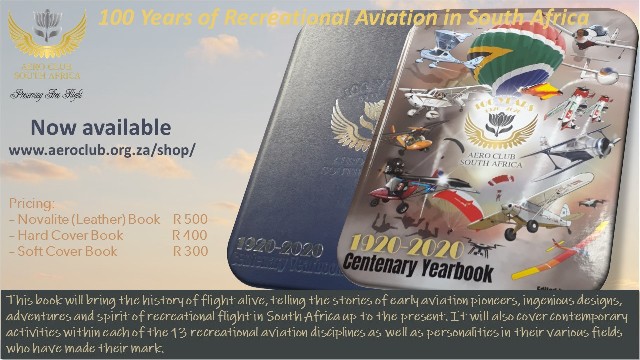

R1,000.00 WORTH OF PRIZES - THE CHOCK NORRIS AVIATION THEMED PHOTO CONTEST
Contestants, please note multiple votes from one device will only be counted once and may led to the entry being disqualified.
Vote now for March week 2 finalists
Vote for Mrch2.1
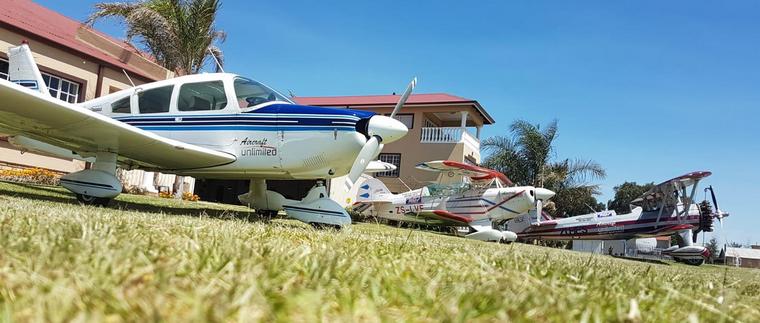
Vote for Mrch2.2
Final entries! The competition will close on 31 March 2021
How to Enter:
Entering your aviation related photo is easy and simple. All images must be emailed to pilotspost@gmail.com with the following detail included:
Your name,
Email address,
Telephone number,
Where the photo was taken,
Phone used,
A theme name of the photo (Optional).
Due to the large amount of entries we expect, Pilot's Post will not acknowledge your entry!!
Entry Rules:
1. When entering the competition and by sending your photo to Pilot's Post, you explicitly grant the publication of your submitted photograph at Pilot's Post team's discretion without any remuneration or obligation to you.
2. Submitted photos must be resized to be less than 1 megabyte in size. If full-size photographs are required, the Pilot's Post team will request them from you.
3. Only photos taken with cell phones will be accepted.
3. All submissions must have an aviation theme.
4. Photo submissions may be cropped and / or resized only. Any other form of photo alteration or manipulation is not allowed and will be disqualified.
5. You may submit up to three entries per week.
Judging:
1. The Pilot's Post team will select the 2 best photos submitted every week and add them into our "Midweek Update" published every Thursday morning, where our readers will then cast their votes by simply clicking the link below the photo of their choice.
2. At the end of each month, a complete article will be published on Pilot's Post to include the weekly photo submissions with the most reader votes. Our readers will then again have the opportunity to cast their votes by simply clicking the link below the photo of their choice. The photo with the highest number of votes will then be judged the Winner of the Month.
3. A prize of a set of Chock Norris personalised Aircraft Chocks with leather storage bag valued at R500
and
a voucher from the Pilot Shop valued at R200.00 will be awarded to each monthly winner
and
a soft cover copy of the Aero Club of South Africa's Centenary Yearbook valued at R300.00 sponsored by Chapter 322 of the EAA of SA
Eligibility:
The Pilot's Post "Chock Norris 2020" aviation related photo competition is only open to photographers resident in South Africa as our prizes are not transferable and can only be redeemed in South Africa.
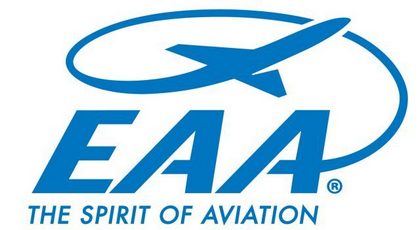
EAA CHAPTER 322
With our MACH program (Member Awards for Chapter Help), your membership could win you a trip to Oshkosh!
Click on the link below today to renew or join!
www.eaa.org.za/membership/membership-form
or for EAA membership information go to
www.eaa.org.za


The following events will to take place under the rules controlling the number of people congregating together and are therefore not open to the general public.
12 & 13 MARCH
POSPONED
Bethlehem Aero Club event TBA. Contact Stephan Fourie E-mail: fouriesj1491@gmail.com Cell: 072 344 9678
16 MARCH
Aero Club of South Africa AGM. Virtual Meeting (Zoom) - Invite details will be made available on the website closer toward the date. Contact Rob Jonkers E-mail: rob@aerosud.co.za Cell: 082 804 7032
26 - 28 MARCH
Large Scale Aerobatics at Barnstormers. Contact Stan 084 268 2025 or Justin 084 465 1000
27 MARCH
EAA Chapter 322 drive-in or fly-in night at Jack Taylor Krugersdorp. We will show a movie on a giant screen on the airfield. Members can drive in or fly in (camp that night on the field). The planned movie is 'Flying the Feathered Edge' with Bob Hoover. Contact Neil Bowden E-mail: neil1@telkomsa.net Cell: 084 674 5674

2 TO 5 APRIL
Sandstone Steam Festival - train rides all day from 10h00. Contact 051 933 2235 Website: www.sandstone-estates.com
7 APRIL
EAA Chapter 322 monthly meeting virtual and Dicky Fritz MOTH Hall, Edenvale. Contact Neil Bowden E-mail: neil1@telkomsa.net Cell: 084 674 5674
17 APRIL
Robertson Flying Club annual breakfast fly-in with spot landing competition. Contact Alwyn du Plessis E-mail: boeredata@breede.co.za Cell: 083 270 5888
17 & 18 APRIL
Sports Aerobatics Club Eastern Cape Regionals Wings Park Airfield. Contact Annie Boon E-mail: chunge@mweb.co.za
15 & 17 APRIL
SAPFA Rally Nationals and Fun Rally - Stellenbosch Airfield. Contact Frank Eckard E-mail: frank.eckard@mweb.co.za Cell: 083 269 1516
24 APRIL
EAA South Africa at Middelburg Airfield AGM details to be announced
23 & 27 APRIL
Aero Club Airweek at Middelburg Airfield. Contact Rob Jonkers E-mail: rob@aerosud.co.za Cell: 082 804 7032
27 APRIL
SAPFA Middelburg Speed Rally at Middelburg Airfield. Contact Jonty Esser E-mail: jonty@promptroofing.co.za Cell: 082 855 9435
1 MAY
Military and history festival. Voortrekker Monument, Pretoria. For more information bemarking@ vdm.org.za


PERFORMANCE CENTRE, FORD MUSTANG DB-H RECEIVED BY NEW OWNERS AND SPITFIRE RESTORATION PROJECT RECEIVES MASSIVE FINANCIAL SUPPORT
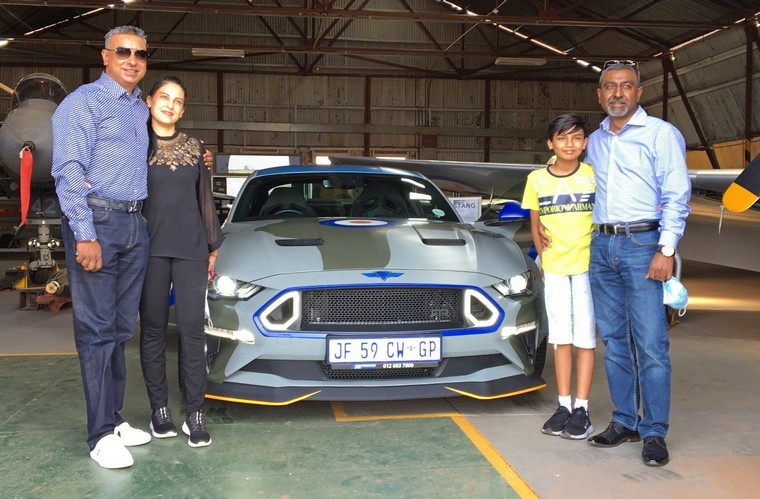
The Pillay family, Darren, Nirvarsha, Craig and Rajen with their new family member, Performance Centre Ford Mustang DB-H
Performance Centre is supporting the South African Air Force Museum Spitfire Restoration Project. Performance Centre offered to build ten unique Ford Mustangs, representing various South African aviation legends. In turn, for each Mustang sold, a very significant donation will be made to the project.
The first of these Mustangs was completed as Mustang DB-H. This represented Spitfire 5518 in her 1950's colour scheme, which she will be returned to on completion of her restoration. Spitfire DB-H was flown by the then Capt Bob Rogers, later Lt Gen Bob Rogers Chief of the SAAF and also a most decorated SAAF pilot. The car bears Capt Roger's name.
Grant Askham (MD, Performance Centre) handing the cheque to Phil Scallan (President of FSAAFM) and Ian Grace, as a donation to the Spitfire Restoration Project.
www.warriorsofthesky.co.za
www.spitfire-restoration.co.za
contact Ian Grace at iang@xsinet.co.za and mobile 082-4525291

BEARHAWK AIRCRAFT ANNOUNCES MODEL B FIRST FLIGHTS AND MODEL 5 KIT DELIVERIES
Bearhawk Aircraft has announced two first flights of Bearhawk Model B aircraft in Idaho and California. The Bearhawk Model B is a 4-Place aircraft designed by engineer Bob Barrows. Also, aircraft kits of the Bearhawk Model 5, a 6-Place design announced last May, have been shipped.
The first four customers of the Model 5 have received their kits and construction is underway. All Bearhawk aircraft models employ superior strength and durability in their construction. Designed to fly fast and land slow, Bearhawk aircraft are renowned for their short field capabilities, gentle slow speed manners and hauling capacity.
The Idaho-based Bearhawk Model B was completed in under one year by Brent Huddleston, a short timeframe considering he's a first-time aircraft builder. Brent says his new Bearhawk has more performance than his previous O-470-powered Cessna 182Q. He had never flown a taildragger, but this did not deter him from comparing the Bearhawk to others in his search for a kit. In the end, according to Brent, "The Bearhawk was the fastest, had the best specs, big doors, and, by comparison, the 182 was too small for even my dog."
Brent installed an IO-540 engine, "ported and polished to 9.5:1 compression," on his Bearhawk. With the big 300-hp engine, Brent and his instructor say it's very responsive, not light, and yet not heavy on the controls. Brent has his own landing strip and already appreciates the difference in climb attitude, noting that the 182 points up in climb, while the Bearhawk is still gaining speed at 1200 fpm and 3/4-throttle but "feels level." He claims speeds of 155 mph TAS and says he's getting many compliments on workmanship, paint and finish.
A second Model B builder, Tim Newsome of California, flew his Bearhawk for the first time last month. The Bearhawk Model B is a "refinement" of the original 4-Place Bearhawk by Bob Barrows. Enhancements to the Model B include a longer, speedier and more stable Riblett 30-413.5 airfoil and weight-saving aluminium fuselage formers as well as window sills and door sills in place of steel. Airfoil shaped empennage surfaces improve stability, control authority, and speed. The 4-Place Bearhawk is long-established as best-in-class for its speed, STOL capability and large payload carrying capacity.
Four Bearhawk Model 5 kits have arrived in the hands of their respective builders. Virgil Irwin took delivery of one in Oklahoma, albeit, the aircraft is ultimately destined for West Africa. "The kit has been fantastic so far," said Virgil. He plans to have it flying by October and meanwhile will be finishing up his A&P certificate. The Bearhawk is Virgil's first complete build, adding, "I will have a couple of guys helping off and on." The instrument panel will be IFR-capable and built around the Garmin G3X. Once in Africa, the aircraft will be based on a dirt runway. Virgil states there is no actual IFR in the country, however, "Niger weather in the Sahara Desert requires special VFR due to dirt in the air."
The West African destination is tied to the missionary work the aircraft will service. Hence, Virgil expects to obtain permission to operate off-airport. He noted that Niger has no general aviation and only six such aircraft are based in the country now. Thus, no avgas is available. While it can be specially ordered, at an exorbitant $22/gal., the Bearhawk will need to run on auto gas. Per its mission, the aircraft will be operating heavy all the time and Virgil needed, "a big aircraft that hauls a lot." The Bearhawk Model 5 fit the criteria. It will employ a Lycoming IO-540 engine with 8.7:1 compression ratio and EFII (Electronic Fuel Injection and Ignition).
A second Model 5 kit was recently delivered to a customer in the Houston area. Ryan Barker of Livingston, Texas, is a commercial pilot. After flying the Bearhawk 4-Place and 6-Place models, Ryan determined the Model 5 is the best all-around plane for him and his family on their grass strip. Ryan is another first-time builder and expects to work solo on the build, enlisting help when needed. He looked at other aircraft, including certified models, for his family of five. "I wanted a family truckster," he stated. "The demo flight really validated my choice. The engine will be an angle-valve IO-540."

Daher's Aircraft Division today announced its 2020 business activity, with the deliveries of 53 aircraft from the Kodiak and TBM single-engine turboprop product lines, as well as orders for another 50 of these aircraft to be delivered in 2021.
The other 11 deliveries in 2020 were Kodiak 100 Series II airplanes - nine of which were in the Americas, along with two provided in Europe for Germany. Customers were primarily fleet operators, such as Costa Rican charter carrier Green Airways; Meta Special Aerospace, an ISR (Intelligence, Surveillance and Reconnaissance) mission provider based in Oklahoma; Bridger Aerospace, which performs firefighting and aerial survey duties from its Montana headquarters.
In addition, there were 20 sales of the pre-owned Kodiak 100 aircraft remaining in the inventory of the sales network after the company acquisition by Daher.
The Kodiak 100 Series II is an unpressurized 10-seat airplane capable of operating on uneven and ultra-short runways, as well as on water in the amphibious version. Daher acquired the Kodiak aircraft's production in 2019, joining the company's very fast pressurized TBM family, produced today in the TBM 910 and TBM 940 versions.
.jpg)
SOUTH KOREA IN FINAL STAGE OF ASSEMBLING FIRST PROTOTYPE OF INDIGENOUS FIGHTER JET

South Korea is in the final stage of assembling a prototype of what would be the country's first indigenously developed fighter jet, which is expected to be unveiled in April, officials said.
In September last year, Korea Aerospace Industries Co. (KAI) got down to the final assembly of a prototype jet and is now in the final stage, according to officials of the Defence Acquisition Program Administration (DAPA).
The prototype is expected to be made public in a rollout event in around end-April, weeks ahead of schedule, they added.
The procurement agency is eyeing 2026 for the completion of development after ground and flight tests. Forty units are planned to be delivered to the Air Force by 2028 and another 80 units by 2032, the officials said.
The aircraft is designed to be able to fly at a maximum speed of Mach 1.81, with its flying range reaching 2,900 kilometres. It bears outward similarities to the fifth-generation F-35A, according to the KAI.
With a maximum payload of 7,700 kilograms, the fighter is capable of installing 10 pods for missiles and fuel barrels. It will be able to carry several types of air-to-air missiles, such as Germany's IRIS-T and European developer MBDA's active radar guided Meteor missiles, it added.
"KF-X is categorized as a '4.5' generation fighter jet. But the platform is designed to be converted into an advanced, fifth-generation one at any time," a DAPA official said.

TECNAM'S AIRCRAFT FOR EQUITABLE COVID VACCINE DELIVERY ENDORSED BY THE US' NATIONAL AIR TRANSPORTATION ASSOCIATION
Italian aircraft manufacturer Tecnam has received an endorsement from the US' National Air Transportation Association (NATA) for their recently launched aircraft P2012 TRAVELCARE developed to increase the reach and efficiency of COVID vaccine delivery.
NATA's Senior Vice President Ryan Waguespack said: "A unique crisis calls for a unique solution like the P2012 TRAVELCARE. NATA applauds Tecnam's leadership in enabling general aviation businesses to serve as crucial links in the COVID vaccine distribution chain to outlying areas across the globe."
In December, Tecnam launched P2012 TRAVELCARE - a next-generation piston aircraft equipped with DESMON ultra-freezers and configured to carry as many as 115,000 COVID vaccine doses to the most remote areas.
In addition to increasing COVID vaccine distributors' reach, the aircraft accelerates the speed of delivery while reducing cost; it is 500x faster than trucks and averages under $0.005 per vaccine per flight hour.
Tecnam's Managing Director Giovanni Pascale Langer said: "We have developed P2012 TRAVELCARE to empower equitable and efficient COVID vaccine delivery. This is Tecnam's contribution to the fight for a COVID-free world."
P2012 TRAVELCARE can transport cargo under all weather conditions and land on runways paved or unpaved. Its freezers can sustain the vaccine temperature at up to -65°C for 10-12h once unplugged from the power source and delivered for further distribution.

EFLYER 2 SERIAL #001 ASSEMBLY UNDERWAY
Assembly of the fuselage for Serial #001 of Bye Aerospace's two-seat all-electric eFlyer 2 is now underway, Bye Aerospace announced. George E. Bye, CEO of Bye Aerospace, said images of the fuselage assembly illustrate important eFlyer 2 program progress. "We appreciate the high-tempo level of support that Steve Ruege and his great team at CUG are giving to this project," Bye said.
In addition, Bye reported that most System Specific Certification Plans (SSCPs) are nearing completion and in final approval coordination with the FAA. "Even with the challenges presented to us by the ongoing Covid-19 pandemic, our team remains laser focused on collaboration efforts with the FAA on the eFlyer 2's certification program," he said.
Bye said he was also pleased to announce the company's latest market update. "Bye Aerospace now has a backlog of 717 purchase deposit agreements for eFlyer 2, four-seat eFlyer 4 and other Bye Aerospace all-electric aircraft," he said. "We are closing several new agreements and expect to make additional market announcements very soon."
Bye Aerospace's current and future families of aircraft feature engineering, research and electric aircraft solutions designed to specifically address compelling market needs. Benefits include five-fold lower operating costs, no CO2 emissions and decreased noise. Bye Aerospace estimates the eFlyer will eventually eliminate the release of millions of metric tons of CO2 each year as its deliveries begin and the general aviation fleet is replaced.

HAL HANDS OVER ALHS TO THE INDIAN NAVY AND INDIAN COAST GUARD
HAL handed over three Advanced Light Helicopter (ALH Mk III) to Indian Navy and two ALHs to Indian Coast Guard as part of its 16 ALHs contract at the ongoing Aero India 2021. The helicopters were handed over by Mr. R. Madhavan, CMD, HAL to Admiral Karambir Singh, Chief of Naval Staff and Mr. K. Natarajan, DG, Coast Guard in the presence of Defence Minister, Mr Rajnath Singh.
ALH has clogged close to 3,00,000 cumulative flight hours and has proven its mettle in versatile operations.
The ALH Mk III is fitted with state-of-the-art Glass cockpit and powerful Shakti engine. The contract involves integration of 19 major systems with the existing ALH MK III that include IFF MKXII & ATC Xpdr with ADS-B Out, V/UHF Communication System, Traffic Alert and Collision Avoidance (TCAS-I), SAR Homer system, Automatic Deployable Emergency Locator Transmitter (ADELT), Loud Hailer, Radio altimeter, Rescue Basket, Medical Intensive Care Unit (MICU), IADS System, AFCS, Digital Video Recording System (SSDVR), Automatic Identification System (AIS), High Intensity Search Light (HISL), Pressure Refueling System, Control grips, EO POD Rev III, Surveillance Radar System and 12.7 mm Gun system.

EMBRAER'S PHENOM 300 BECOMES WORLD'S BEST-SELLING LIGHT JET FOR THE NINTH CONSECUTIVE YEAR AND MOST DELIVERED TWINJET IN 2020
For the ninth consecutive year, Embraer's Phenom 300 series has become the world's best-selling light jet according to numbers released by the General Aviation Manufacturers Association (GAMA). Embraer delivered 50 Phenom 300 series light jets in 2020, making it the most delivered light jet of the year.
This is the ninth consecutive year that the Phenom 300 series has achieved this milestone, having accrued more than 590 deliveries since entering the market in December 2009. In 2020, the Phenom 300 series was also the most delivered jet model out of all twinjets in the market.
"The continued success of the Phenom 300 series, as the best-selling light jet in the world, is a reflection of our dedicated commitment to deliver the ultimate customer experience in business aviation," says Michael Amalfitano, President & CEO of Embraer Executive Jets. "At Embraer, we are always improving our market leading products. We are continuously looking for advancements in performance, comfort and technology. The Phenom 300E not only boasts advanced capabilities, but also delivers the most sophisticated combination of performance, technology and ergonomics of any light business jet in the industry."
Originally launched in 2005, the Phenom 300 series is in operation in more than 30 countries and has accumulated more than one million flight hours. Embraer is continuously investing in the competitiveness of the Phenom 300E with enhancements to its comfort, technology, performance and operational efficiency resulting in the highest residual value in the market.
In January of 2020, Embraer announced the new and enhanced Phenom 300E, followed by its ANAC, EASA and FAA approval in March, achieving triple-certification. The first delivery of the new and enhanced Phenom 300E occurred in June of 2020.
With its unparalleled technology, exceptional comfort, and stunning performance, the Phenom 300E sets the highest standard of excellence in the light jet category. In terms of performance, the new, enhanced Phenom 300E is even faster, capable of reaching Mach 0.80, becoming the fastest single-pilot jet in production, able to deliver high-speed cruise of 464 knots and a five-occupant range of 2,010 nautical miles (3,724 km) with NBAA IFR reserves.
Additional technology enhancements include an avionics upgrade, featuring a runway overrun awareness and alerting system (ROAAS) ? the first technology of its kind to be developed and certified in business aviation ? as well as predictive windshear, Emergency Descent Mode, PERF, TOLD and FAA Datacom, among others. The Phenom 300E also features 4G connectivity via Gogo AVANCE L5.
The new, comfort-enhancing features on this jet include a quieter cabin, more legroom in the cockpit and a new premium interior option - the Bossa Nova edition. Named for the Brazilian style of jazz music, and Portuguese for "new trend," the optional Bossa Nova edition encompasses a package of Embraer's latest interior developments, with features such as carbon fibre accents and Embraer's exclusive Ipanema sew style. It is also the first of the Phenom 300 series to feature piano black surfaces.

AUSTRALIAN GOVERNMENT TO CO-DEVELOP AN ADDITIONAL THREE AIRCRAFT WITH BOEING
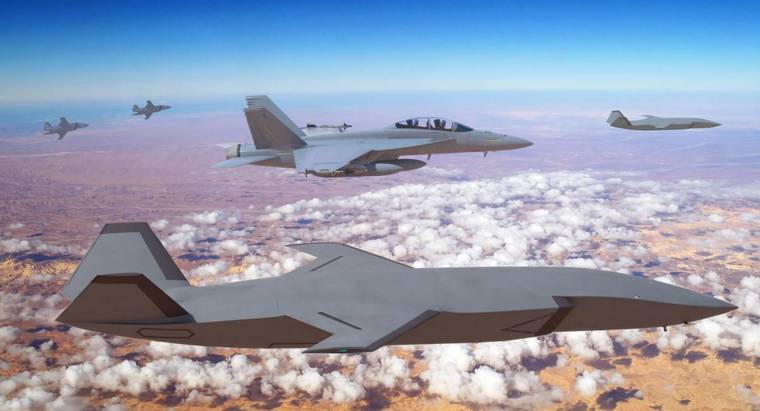
Boeing [NYSE: BA] Australia welcomes the announcement by the Australian government to co-develop a further three Loyal Wingman aircraft to advance the air-teaming vehicle, payloads and associated support and training capabilities.
"The Australian government's continued investment in the innovative Loyal Wingman program will create jobs and opportunities for over 35 Australian suppliers and small businesses, including BAE Systems Australia, RUAG Australia, AME Systems and Ferra Engineering," said Dr. Brendan Nelson, president of Boeing Australia, New Zealand & South Pacific.
The contract will support the maturation of the aircraft design, evolution of current and future payloads and create the sustainment system for the aircraft in operations. It will also advance Airpower Teaming System advanced concepts through digital testing and demonstration.
"In addition to progressing the air vehicle design and support system, we will further develop the aircraft's mission system including advanced AI decision-making capabilities and new payloads," said Dr. Shane Arnott, program director of the Boeing Airpower Teaming System.
"Continued digital engineering and significantly expanded live testing of the system will provide RAAF and Boeing with the ability to jointly take the concept to the next level, activities that are critical for us to rapidly understand how the Airpower Teaming System can be employed in the future battlespace."

UK, BIRMINGHAM INTERNATIONAL AIRPORT

The crew of a British Aerospace ATP-F (LFD) operated by West Air Europe was on a flight from Guernsey Airport to Birmingham International Airport. The weather in Birmingham for their arrival was forecast to be a strong wind from the southwest with good visibility and a high cloud base. The co-pilot was Pilot Flying (PF) for the sector.
During the flare to land the aircraft drifted to the right of the centreline with the nose about 20° left of the runway direction. A go-around was commenced. At the request of the co-pilot, the commander became PF for the second approach which was again a stable.
The aircraft touched down and shortly afterwards, departed off the paved runway to the left. The distance from the aircraft first leaving the paved surface to when the last wheel returned to the paved surface was 450 m.
After stopping for an inspection by ground operations personnel, the crew taxied the aircraft to a stand. Subsequent engineering inspections revealed no damage to the aircraft although one main wheel tyre was replaced. There were no injuries to the crew who were the only occupants.
AAIB Conclusion:
Despite the challenging conditions, the crew did not discuss the conditions in any detail. They did not brief who would be holding the control column during either landing roll, or what actions they would take if they were required to abandon the approach or landing. The first approach resulted in confusion between the crew over going around which could have itself resulted in an incident or accident. The confusion was eventually overcome by the commander calling for a go-around. Neither attempt at landing used the crosswind technique as laid down in the manufacturers and operator's manuals.

South Africa, Plettenberg Airport: A Hawker 4000 operated by Comair Flight Services veered off the side of the runway on landing at Plettenberg Airport. There were no reported injuries. The aircraft suffered only minor damage.
South Africa, near Alldays, Limpopo: A Robinson R22 Beta II operated by Hanley Wildlife Services with two occupants suffered substantial damage when during a game capture operation, it impacted the ground during an emergency landing near Alldays, Limpopo. Both occupants escaped unhurt.
Botswana, near Xumabee Game Ranch: A Helicopter female rapper Sasa Klaas (Sarona Motlhagodi) and the pilot on board crashed under unknown circumstances near a ranch farm, killing the passenger.
Algeria, Ghardaïa-Noumérat Airport: An Air Algérie ATR 72-500 with 34 occupants on a domestic scheduled passenger flight during the approach to Ghardaïa after a flight from Algiers, the nose landing gear failed to deploy after the flight crew selected the undercarriage down. The flight crew failed to resolve the issue and performed a nosegear-up landing with fire trucks and ambulances standing by. There were no reports of injuries.

France, Touques, Calvados, Normandy: A Aérospatiale AS 350B Ecureuil operated by Dolijet crashed soon after take-off from a private property in Normany. The pilot and lone passenger died in the crash. The deceased passenger has been identified as Olivier Dassault, heir of late Serge Dassault, himself son of Marcel Dassault, founder of Dassault Aviation.
USA, near Edwards Air Force Base, CA: An Atlas Impala Mk I (MB.326M) operating for the National Test Pilot School (NTPS) with two onboard impacted rural desert terrain near the Edwards Air Force Base (EDW/KEDW), California. The training jet was destroyed and the two crew successfully ejected.
Iran, Isfahan Airport: An Iran Air Fokker 100 with an unknown number of passengers on a domestic scheduled passenger flight from Ahwaz Airport to Mashhad Airport made an emergency landing at Isfahan Airport after an alleged attempted hijacking was disrupted by authorities.
China, Ji'an County: A Beidahuang General Airlines Beechcraft B300 King Air 350i with five on board operated on behalf of China's Meteorological Administration on a cloud seeding mission crashed into a residential area in Ji'an County, China. All five occupants of the King Air were killed. Three houses were damaged and one villager suffered minor injuries.
Austria, Steinfeld, Spittal/Drau: A Lancair 235 with two on board made a forced landing after one of the three propeller blades separated in flight. Both occupants escaped unhurt and the plane sustained substantial damage.


7 March 1956

Dan Perkins, engineer at Britain's Royal Aircraft Establishment, makes his first flight in an inflatable airplane in Bedfordshire, England. It takes 25 min to inflate it, using a large domestic vacuum cleaner.
A leading light in this work was Dan Perkins. He redesigned the small barrage balloon carried by ships so that its shape produced lift and reduced the amount of hydrogen needed for it to fly. He went on to build (with his own money) an inflatable man-powered aeroplane, the Reluctant Phoenix.
After Dan Perkins' death, the research was continued by Francis Kiernan, who produced more than a dozen inflatable inherently stable 45° swept delta wings of varying sizes.

PLEASE GO TO
www.youtube.com/channel/UCCuRVZAGodT6sztTeXBGeMw
and subscribe to our YouTube channel

 |
 |
 Copyright © 2024 Pilot's Post PTY Ltd
The information, views and opinions by the authors contributing to Pilot’s Post are not necessarily those of the editor or other writers at Pilot’s Post.
Copyright © 2024 Pilot's Post PTY Ltd
The information, views and opinions by the authors contributing to Pilot’s Post are not necessarily those of the editor or other writers at Pilot’s Post.